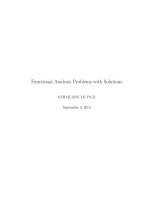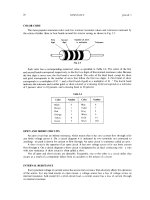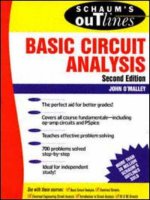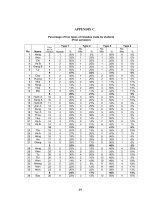F analysis problems solutions AnhQLe full
Bạn đang xem bản rút gọn của tài liệu. Xem và tải ngay bản đầy đủ của tài liệu tại đây (494.23 KB, 100 trang )
Functional Analysis Problems with Solutions
ANH QUANG LE, Ph.D.
September 3, 2013
www.MATHVN.com - Anh Quang Le, Ph.D
Contents
Contents
1
1 Normed and Inner Product Spaces
3
2 Banach Spaces
15
3 Hilbert Spaces
27
3.1
Hilbert spaces . . . . . . . . . . . . . . . . . . . . . . . . . . . . . . . 27
3.2
Weak convergence . . . . . . . . . . . . . . . . . . . . . . . . . . . . . 40
4 Linear Operators - Linear Functionals
45
4.1
Linear bounded operators . . . . . . . . . . . . . . . . . . . . . . . . 45
4.2
Linear Functionals . . . . . . . . . . . . . . . . . . . . . . . . . . . . 63
5 Fundamental Theorems
73
6 Linear Operators on Hilbert Spaces
87
1
www.MATHVN.com
www.MATHVN.com - Anh Quang Le, Ph.D
2
CONTENTS
Notations:
• B(X, Y ): the space of all bounded (continuous) linear operators from X to Y .
• Image (T ) ≡ Ran(T ): the image of a mapping T : X → Y .
w
• xn −
→ x: xn converges weakly to x.
• X ∗ : the space of all bounded (continuous) linear functionals on X.
• F or K: the scalar field, which is R or C.
• Re, Im: the real and imaginary parts of a complex number.
www.MATHVN.com
www.MATHVN.com - Anh Quang Le, Ph.D
Chapter 1
Normed and Inner Product Spaces
Problem 1.
Prove that any ball in a normed space X is convex.
Solution.
Let B(x0 ; r) be any ball of radius r > 0 centered at x0 ∈ X, and x, y ∈ B(x0 ; r).
Then
kx − x0 k < r and ky − x0 k < r.
For every a ∈ [0, 1] we have
kax + (1 − a)y − x0 k = k(x − x0 )a + (1 − a)(y − x0 )k
≤ akx − x0 k + (1 − a)ky − x0 k
< ar + (1 − a)r = r.
So ax + (1 − a)y ∈ B(x0 ; r). ¥.
Problem 2.
Consider the linear space C[0, 1] equipped with the norm
Z 1
kf k1 =
|f (x)|dx.
0
Prove that there is no inner product on C[0, 1] agreed with this norm.
3
www.MATHVN.com
www.MATHVN.com - Anh Quang Le, Ph.D
4
CHAPTER 1. NORMED AND INNER PRODUCT SPACES
Solution.
We show that the norm k.k1 does not satisfy the parallelogram law. Let
f (x) = 1 and g(x) = 2x.
Then
Z
Z
1
kf k1 =
0
while
Z
1
kf − gk1 =
0
1
1.dx = 1, kgk1 =
|2x|dx = 1,
0
1
|1 − 2x|dx = , kf + gk1 =
2
Thus,
kf − gk21 + kf + gk21 =
Z
1
|1 + 2x|dx = 2.
0
17
6= 2(kf k21 + kgk21 ) = 4.
4
¥
Problem 3.
Consider the linear space C[0, 1] equipped with the norm
kf k = max |f (t)|.
t∈[0,1]
Prove that there is no inner product on C[0, 1] agreed with this norm.
Solution.
We show that the parallelogram law with respect to the given norm does not hold
for two elements in C[0, 1].
Let f (t) = t, g(t) = 1 − t, t ∈ [0, 1]. Then f, g ∈ C[0, 1] and
kf k = max t = 1, kgk = max (1 − t) = 1,
t∈[0,1]
t∈[0,1]
and
kf + gk = max 1 = 1, and kf − gk = max | − 1 + 2t| = 1.
t∈[0,1]
t∈[0,1]
Thus,
kf − gk21 + kf + gk21 = 2 6= 2(kf k21 + kgk21 ) = 4.
¥
Problem 4.
Prove that:
If the unit sphere of a normed space X contains a line segment [x, y] where x, y ∈
X and x 6= y , then x and y are linearly independent and kx + yk = kxk + kyk .
www.MATHVN.com
www.MATHVN.com - Anh Quang Le, Ph.D
5
Solution.
Suppose that the unit sphere contains a line segment [x, y] where x, y ∈ X and
x 6= y. Then
kax + (1 − a)yk = 1 for any a ∈ [0, 1].
Choose a = 1/2 then we get k 12 (x + y)k = 1, that is kx + yk = 2. Since x and y
belong to the unit sphere, we have kxk = kyk = 1. Hence
kx + yk = kxk + kyk.
Let us show that x, y are linearly independent. Assume y = βx for some β ∈ C. We
have
1 = kax + (1 − a)βxk = |a + (1 − a)β|.
For a = 0 we get |β| = 1 and for a = 1/2 we get |1 + β| = 2. These imply that
β = 1, and so x = y, which is a contradiction. ¥
Problem 5.
Prove that two any norms in a finite dimensional space X are equivalent.
Solution.
Since equivalence of norms is an equivalence relation, it suffices to show that an
arbitrary norm k.k on X is equivalent to the Euclidian norm P
k.k2 . Let {e1 , ..., en } be
a basis for X. Every x ∈ X can be written uniquely as x = nk=1 ck ek . Therefore,
!1/2
!1/2 Ã n
à n
n
X
X
X
kek k2
≤ Akxk2 ,
|ck |2
|ek |kek k ≤
kxk ≤
k=1
k=1
k=1
P
1/2
where A = ( nk=1 |ek |2 ) is a non-zero constant. This shows that the map x 7→ kxk
is continuous w.r.t. the Euclidian norm. Now consider S = {x : kxk2 = 1}. This is
just the unit sphere in (X, k.k2 ), which is compact. The map
S → R defined by x 7→ kxk
is continuous, so it attains a minimum m and a maximum M on S. Note that m > 0
because S 6= ∅. Thus, for all x ∈ S, we have
m ≤ kxk ≤ M.
Now, for x ∈ X, x 6= 0,
x
kxk2
∈ S, so
m≤
kxk
≤ M.
kxk2
www.MATHVN.com
www.MATHVN.com - Anh Quang Le, Ph.D
6
CHAPTER 1. NORMED AND INNER PRODUCT SPACES
That is
mkxk2 ≤ kxk ≤ M kxk2 .
Hence, the two norms are equivalent. ¥
Problem 6.
Let X be a normed space.
(a) Find all subspaces of X which are contained in some ball B(a; r) of X.
(b) Find all subspaces of X which contain some ball B(x0 ; ρ) of X.
Solution.
(a) Let Y be a subspace of X which is contained in some ball B(a; r) of X. Note
first that the ball B(a; r) must contain the vector zero of X (and so of Y ); otherwise,
the question is impossible. For any number A > 0 and any x ∈ Y , we have Ax ∈ Y
since Y is a linear space. By hypothesis Y ⊂ B(a; r), so we have Ax ∈ B(a; r). This
implies that kAxk < r + kak. Finally
kxk <
r + kak
.
A
A > 0 being arbitrary, it follows that kxk = 0, so x = 0. Thus, there is only one
subspace of X, namely, Y = {0}, which is contained in some ball B(a; r) of X.
(b) Let Z be a subspace of X which contain some ball B(x0 ; ρ) of X. Take any
x ∈ B(0; ρ). Then x + x0 ∈ B(x0 ; ρ) and so x + x0 ∈ Z since Z ⊃ B(x0 ; ρ). Now,
since x0 ∈ Z, x + x0 ∈ Z and Z is a linear space, we must have x ∈ Z. Hence
B(0; ρ) ⊂ Z.
ρx
Now for any nonzero x ∈ X, we have 2kxk
∈ B(0; ρ) ⊂ Z. Hence x ∈ Z. We can
conclude that Z = X. In other words, the only subspace of X which contains some
ball B(x0 ; ρ) of X is X itself.
¥
Problem 7.
Prove that any finite dimensional normed space :
(a) is complete (a Banach space),
(b) is reflexive.
Solution.
Let X be a finite dimensional normed space. Suppose dim X = d.
www.MATHVN.com
www.MATHVN.com - Anh Quang Le, Ph.D
7
(a) By Problem 5, it suffices to consider the Euclidian norm in X. Let {e1 , ..., ed }
be a basis for X. For x ∈ X there exist numbers c1 , ..., cd such that
à d
!1/2
d
X
X
x=
ck ek and kxk =
|ck |2
.
k=1
k=1
P
(n)
Let (x(n) ) be a Cauchy sequence in X. If for each n, x(n) = dk=1 ak ek then
!1/2
à d
X (n)
(m)
→ 0 as n, m → ∞.
kx(n) − x(m) k =
|ak − ak |2
k=1
Hence, for every k = 1, ..., d,
(n)
(m)
|ak − ak | → 0 as n, m → ∞.
(n)
Therefore, each sequence of numbers (ak ) is a Cauchy sequence, so
(n)
(0)
ak → ak
Let a =
Pd
k=1
as n → ∞ for every k = 1, 2, ..., d.
(0)
ak ek then x(n) → a ∈ X.
(b) Let f ∈ X ] where X ] is the space of all linear functionals on X. We have
!
à d
d
d
X
X
X
ck α k ,
ck f (ek ) =
ck ek =
f (x) = f
k=1
k=1
k=1
where αk = f (ek ). Let us define fk ∈ X ] by the relation fk (x) = ck , k = 1, ..., d.
For any x ∈ X and f ∈ X ] , we get
f (x) =
d
X
fk (x)αk , i.e., f =
Hence,
X ] ≤ d.
Pdim
d
Let
α f = 0. Then, for any x ∈ X,
Pd k=1 k k
¯ k ek , we obtain fk (x) = α
¯ k , and
x = k=1 α
k=1
αk fk (x) =
αk fk .
k=1
k=1
d
X
d
X
d
X
Pd
k=1
αk fk (x) = 0, and by taking
|αk |2 = 0.
k=1
Hence, αk = 0 for all k = 1, ..., d and thus, dim X ] = d. For the space X ∗ we have
X ∗ ⊂ X ] , so dim X ∗ = n ≤ d and dim(X ∗ )] = n. From the relation X ⊂ (X ∗ )∗ ⊂
(X ∗ )] we conclude that d ≤ n. Thus, n = d, and so X = (X ∗ )∗ . ¥
www.MATHVN.com
www.MATHVN.com - Anh Quang Le, Ph.D
8
CHAPTER 1. NORMED AND INNER PRODUCT SPACES
Problem 8. ( Reed-Simon II.4)
(a) Prove that the inner product in a normed space X can be recovered from the
polarization identity:
i
1h
hx, yi = (kx + yk2 − kx − yk2 ) − i(kx + iyk2 − kx − iyk2 ) .
4
(b) Prove that a normed space is an inner product space if and only if the norm
satisfies the parallelogram law:
kx + yk2 + kx − yk2 = 2(kxk2 + kyk2 ).
Solution.
(a) For the real field case, the polarization identity is
1
hx, yi = (kx + yk2 − kx − yk2 ). (∗)
4
We use the symmetry of the inner product and compute the right hand side of ():
Ô
1
1Ê
(kx + yk2 kx − yk2 ) =
hx + y, x + yi hx y, x yi
4
4
Ô
1Ê
=
hx, yi + hy, xi
2
= hx, yi.
For the complex field case, we again expand the right hand side, using the relation
we just established:
i
1h
2
2
2
2
(kx + yk − kx − yk ) − i(kx + iyk kx iyk )
4
Ô iÊ
Ô
1Ê
= hx, yi + hy, xi − hx, iyi + hiy, xi
2
2
1
1
i2
i2
= hx, yi + hy, xi − hx, yi + hy, xi
2
2
2
2
= hx, yi.
(b) If the norm comes from an inner product, then we have
kx + yk2 + kx − yk2 = hx + y, x + yi + hx − y, x − yi
= 2hx, xi + 2hy, yi + hx, yi + hy, xi − hx, yi − hy, xi
= 2(kxk2 + kyk2 ).
www.MATHVN.com
www.MATHVN.com - Anh Quang Le, Ph.D
9
Now suppose that the norm satisfies the parallelogram law. Assume the field is
C, and define the inner product via the polarization identity from part (a). If
x, y.z ∈ X, we write
x+y =x+
y+z y−z
y+z y−z
+
, x+z =x+
−
,
2
2
2
2
and we have
hx, yi + hx, zi =
+
=
−
=
−
=
−
=
¢
1¡
kx + yk2 + kx − yk2 − kx − yk2 − kx − zk2
4
¢
i¡
kx + iyk2 + kx + izk2 − kx − iyk2 − kx − izk2
4Ã
°
°
°2 °
°
°2 °
°!
°
° y + z °2 °
°
° y − z °2
y
+
z
y
+
z
1 °
°
°
°x +
° +°
°
°
°
° 2 ° − °x − 2 ° − ° 2 °
2 °
2 °
ð
°2 °
°
°
°2 °
°!
°
° y + z °2 °
°
° y − z °2
i °
y
+
z
y
+
z
°x + i
° + °i
°
°
°
°
°
° 2 ° − °x − i 2 ° − °i 2 °
2 °
2 °
ð
°2 °
°
°
°2 !
°
°
°
°
° y + z °2 ° y − z °2 °
1 °
y
+
z
y
+
z
°x +
° +°
° −°
° − °x −
°
° 2 °
° 2 °
°
2 °
2 °
2 °
ð
°2 °
°
°
°2 !
°
°
°
°
° y + z °2 ° y − z °2 °
i °
y
+
z
y
+
z
°x + i
° + °i
° − °i
° − °x − i
°
° 2 °
° 2 °
°
2 °
2 °
2 °
¢
1¡
kx + y + zk2 + kxk2 − kx − (y + z)k2 − kxk2
4
¢
i¡
kx + i(y + z)k2 + kxk2 − kx − i(y + z)k2 − kxk2
4
hx, y + zi.
This holds for all x, y, z ∈ X, so, in particular,
hx, nyi = nhx, yi for n ∈ N.
And it also satisfies
hx, ryi = rhx, yi for r ∈ Q.
Moreover, again by the polarization identity, we have
¢ i¡
¢
1¡
kx + iyk2 − kx − iyk2 − kx − yk2 − kx + yk2
4
4
= ihx, yi.
hx, iyi =
Combining these results we have
hx, αyi = αhx, yi for α ∈ Q + iQ.
www.MATHVN.com
www.MATHVN.com - Anh Quang Le, Ph.D
10
CHAPTER 1. NORMED AND INNER PRODUCT SPACES
Now, if α ∈ C, by the density of Q + iQ in C, there exists a sequence (αn ) in Q + iQ
converging to α. It follows that
hx, αyi = αhx, yi for α ∈ C.
Thus the h., .i is linear.
Since ki(x − iy)k = kx − iyk, we have
hy, xi = hx, yi,
and
¢
1
i¡
hx, xi = (k2xk2 ) − |1 + i|kxk2 − |1 − i|2 kxk2 = kxk2 .
4
4
So this shows that the norm is induced by h., .i and that it is also positive definite,
and thus it is an inner product.
¥
Problem 9. (Least square approximation. Reed-Simon II.5)
Let X be an inner product space and let {x1 , ..., xN } be an orthonormal set.
Prove that
°
°
N
°
°
X
°
°
cn xn °
°x −
°
°
n=1
is minimized by choosing cn = hxn , xi.
Solution.
For every x ∈ X, we write
x=
N
X
hxn , xixn + z, for some z ∈ X.
n=1
We observe that for all n = 1, ..., N ,
hxn , zi = hxn , xi −
N
X
hxn , xihxn , xk i
k=1
= hxn , xi − hxn , xi = 0.
Therefore z⊥xn . Then due to (∗) we can write
x−
N
X
n=1
c n xn =
N
X
¡
|n=1
¢
hxn , xi − cn xn +z.
{z
zN
www.MATHVN.com
}
(∗)
www.MATHVN.com - Anh Quang Le, Ph.D
11
Since z⊥zN , we have
°
°2
N
°
°
X
°
°
x
−
c
x
= kzN k2 + kzk2
°
n n°
°
°
n=1
N
X
¯
¯
¯hxn , xi − cn ¯2 + kzk2 ,
=
n=1
which attains its minimum if
cn = hxn , xi for all n = 1, ..., N.
¥
Review: Quotient normed space.
• Let X be a vector space, and let M be a subspace of X. We define an equivalence relation on
X by
x ∼ y if and only if x − y ∈ M.
For x ∈ X, let [x] = x + M denote the equivalence class of x and X/M the set of all equivalence
classes. On X/M we define operations:
[x] + [y] = [x + y]
α[x] = [αx], α ∈ C.
Then X/M is a vector space.
If the subspace M is closed, then we can define a norm on X/M by
k[x]k = inf kyk = inf kx + mk = inf kx − zk = d(x, M ).
y∈[x]
m∈M
m∈M
What a ball in X/M looks like?
B([x0 ]; r) := {[x] : k[x] − [x0 ]k < r} = {x + M : kx − x0 + M k < r}.
• Suppose that M is closed in X. The canonical map (the natural projection) is defined by
π : X → X/M, π(x) = [x] = x + M.
It can be shown that kπ(x)k ≤ kxk, ∀x ∈ X, so π is continuous.
Problem 10.
Let X be a normed space and M a closed subspace of X. Let π : X → X/M
be the canonical map. Show that the topology induced by the standard norm on
X/M is the usual quotient topology, i.e. that O ⊂ X/M is open in X/M if and
only if π −1 (O) is open in X.
www.MATHVN.com
www.MATHVN.com - Anh Quang Le, Ph.D
12
CHAPTER 1. NORMED AND INNER PRODUCT SPACES
Solution.
• If O is open in X/M , then π −1 (O) is open in X since π is continuous.
• Now suppose that O ⊂ X/M and that π −1 (O) is open in X. We show that O is
open in X/M . Consider an open ball B(0; r), r > 0 in X. Let x ∈ B(0; r). Then
kxk < r, and so
k[x]k ≤ kxk < r.
On the other hand, if k[x]k < r, then there is an y ∈ M such that kx + yk < r.
Hence x + y ∈ B(0; r), and so
¡
¢
[x] = π(x + y) ∈ π B(0; r) .
If [x0 ] ∈ O, then x0 ∈ π −1 (O). Since π −1 (O) is open in X, there is an r > 0 such
that
B(x0 ; r) ⊂ π −1 (O).
This implies that
¡
¢
¡
¢
O = ππ −1 (O) ⊃ π B(x0 ; r) = π x0 + B(0; r) = {x + M : kx − x0 + M k < r}.
The last set is the open ball of radius r > 0 centered at [x0 ] ∈ O. Thus O is open
in X/M.
¥
Problem 11.
Let X = C[0, 1], M = {f ∈ C[0, 1] : f (0) = 0}. Show that X/M = C.
Solution.
Given [f ] ∈ X/M , let ϕ([f ]) = f (0). Then the map ϕ : X/M → C is well-defined.
Indeed, if [f ] = [g], then (f − g)(0) = 0 so f (0) = g(0). It is clearly linear.
If f ∈ X, then g = f − f (0) ∈ M , and so f − g = f (0) is constant, which tells us
that
k[f ]k = |f (0)| = |ϕ([f ])|,
so ϕ is an isometry (and thus injective and continuous). Finally, constants are in
X = C[0, 1], so ϕ is surjective and thus an isometric isomorphism. ¥
Problem 12.
P
If 0 < p < 1 then `p is a vector space but kxkp = ( n |xn |p )1/p is not a norm for
`p .
www.MATHVN.com
www.MATHVN.com - Anh Quang Le, Ph.D
13
Solution.
Recall that if x = (x1 , x2 , ...), y = (y1 , y2 , ...) ∈ `p and α ∈ C then
x + y = (x1 + y1 , x2 + y2 , ...) and αx = (αx1 , αx2 , ...).
It is clear that αx ∈ `p . We show that x + y ∈ `p . For t ≥ 0 it not hard to see that
(1 + t)p ≤ 1 + tp , 0 < p < 1. This implies that
(a + b)p ≤ ap + bp , 0 < p < 1 and a, b ≥ 0.
Therefore,
kx + ykpp ≤ kxkpp + kykpp .
Since both kxkpp and kykpp are bounded, kx + ykpp is bounded. Hence x + y ∈ `p .
To show k.kp is not a norm for `p , let us take an example: If
x = (1, 0, ...) and y = (0, 1, 0, ...)
then kxkp = kykp = 1 but kx + ykp = 21/p > 2 since 1/p > 1. Therefore,
kx + ykp > kxkp + kykp . ¥
Problem 13.
Suppose that X is a linear space with inner product h., .i. If xn → x and yn → y
as n → ∞, prove that
hxn , yn i → hx, yi as n → ∞.
Solution.
Using the Cauchy-Schwarz and triangle inequalities, we have
|hxn , yn i − hx, yi| ≤
≤
≤
≤
|hxn − x, yn i| + |hx, yn − yi|
kxn − xkkyn k + kxkkyn − yk
kxn − xk(kyn − yk + kyk) + kxkkyn − yk
kxn − xkkyn − yk + kxn − xkkyk + kxkkyn − yk.
Since kxn − xk → 0 and kyn − yk → 0 as n → ∞, we see that
hxn , yn i → hx, yi as n → ∞.
www.MATHVN.com
¥
www.MATHVN.com - Anh Quang Le, Ph.D
14
CHAPTER 1. NORMED AND INNER PRODUCT SPACES
Problem 14.
Prove that if M is a closed subspace and N is a finite dimensional subspace of a
normed space X, then M + N := {m + n : m ∈ M, n ∈ N } is closed.
Solution.
Assume dim N = 1, say N = Span{x}. The case x ∈ M is trivial. Suppose x ∈
/ M.
Consider the sequence zk := αk x + mk , where mk ∈ M, αk ∈ C, and suppose
zk ∈ M + N → y as k → ∞. We want to show y ∈ M + N . The sequence (αk )
is bounded; otherwise, there exists a subsequence (αk0 ) such that 0 < |αk0 | → ∞ as
k 0 → ∞. Then
zk 0
mk 0
and
→ 0 as k 0 → ∞,
αk0
αk0
so x must be 0, which is in M . This is a contradiction. Consequently, (αk ) is bounded
and therefore it has a subsequence (αk0 ) which is converging to some α ∈ C. Thus
mk0 = zk0 − αk0 x → y − αx as k 0 → ∞.
Hence, y − αx is in M since M is closed. Thus y ∈ M + N .
The solution now follows by induction. ¥
www.MATHVN.com
www.MATHVN.com - Anh Quang Le, Ph.D
Chapter 2
Banach Spaces
Problem 15.
Let
if the series
P∞X be a normed space. Prove that X is a Banach space if andPonly
∞
n=1 an converges, where (an ) is any sequence in X satisfying
n=1 kan k < ∞.
Solution.
P∞
Suppose that
Pn X is complete. Let (an ) be a sequence in X such that n=1 kan k < ∞.
Let Sn = i=1 ai be the partial sum. Then for m > n,
° m
°
m
°X °
X
°
°
kSm − Sn k = °
ai ° ≤
kai k.
°
°
i=n+1
i=n+1
P
Pm
By hypothesis, the series ∞
n=1 kan k converges, so
i=n+1 kai k → 0 as n → ∞.
Therefore, (Sn ) is P
a Cauchy sequence in the Banach space X. Thus, (Sn ) converges,
that is, the series ∞
n=1
P an converges.
P∞
Conversely, suppose ∞
n=1 an converges in X whenever
n=1 kan k < ∞. We show
that X is complete. Let (yn ) be a Cauchy sequence in X. Then
1
whenever m > n1 ,
2
1
− ym k < 2 whenever m > n2 > n1 .
2
∃n1 ∈ N : kyn1 − ym k <
∃n2 ∈ N : kyn2
Continuing in this way, we see that there is a sequence (nk ) strictly increasing such
that
1
kynk − ym k < k whenever m > nk .
2
15
www.MATHVN.com
www.MATHVN.com - Anh Quang Le, Ph.D
16
CHAPTER 2. BANACH SPACES
In particular, we have
kynk+1 − ynk k <
1
for all k ∈ N.
2k
Set xk = ynk+1 − ynk . Then
n
X
kxk k =
k=1
n
X
kynk+1 − ynk k <
k=1
n
X
1
.
k
2
k=1
P∞
It
k=1 kxk k < ∞. By hypothesis, there is an x ∈ X such that
Pmfollows that
k=1 xk → x as m → ∞. But we have
m
X
k=1
xk =
m
X
(ynk+1 − ynk )
k=1
= ynm+1 − yn1 .
Hence ynm → x + yn1 in X as m → ∞. Thus, the sequence (yn ) has a convergent
subsequence and so must itself converges. ¥
Problem 16.
Let X be a Banach space. Prove that the closed unit ball B(0; 1) ⊂ X is compact
if and only if X is finite dimensional.
Solution.
• Suppose dim X = n. Then X is isomorphic to Rn (with the standard topology).
The result then follows from the Heine-Borel theorem.
• Suppose that X is not finite dimensional. We want to show that B(0; 1) is not
compact. To do this, we construct a sequence in B(0; 1) which have no convergent
subsequence.
We will use the following fact usually known as Riesz’s Lemma: (See the proof below)
Let M be a closed subspace of a Banach space X. Given any r ∈ (0, 1), there exists an x ∈ X such
that
kxk = 1 and d(x, M ) ≥ r.
Pick x1 ∈ X such that kx1 k = 1. Let S1 := Span {x1 }. Then S1 is closed. According
to Riesz’s Lemma, there exists x2 ∈ X such that
1
kx2 k = 1 and d(x2 , S1 ) ≥ .
2
www.MATHVN.com
www.MATHVN.com - Anh Quang Le, Ph.D
17
Now consider the subspace S2 generated by {x1 , x2 }. Since X is infinite dimensional,
S2 is a proper closed subspace of X, and we can apply the Riesz’s Lemma to find
an x3 ∈ X such that
1
kx3 k = 1 and d(x3 , S2 ) ≥ .
2
If we continue to proceed this way, we will have a sequence (xn ) and a sequence of
closed subspaces (Sn ) such that for all n ∈ N
1
kxn k = 1 and d(xn+1 , Sn ) ≥ .
2
It is clear that the sequence (xn ) is in B(0; 1), and for m > n we have
1
kxn − xm k ≥ d(xm , Sn ) ≥ .
2
Therefore, no subsequence of (xn ) can form a Cauchy sequence. Thus, B(0; 1) is not
compact. ¥
Proof of Riesz’s Lemma:
Take x1 ∈
/ M . Put d = d(x1 , M ) = inf m∈M km − x1 k. Then d > 0 since M is closed. For any
ε > 0, by definition of the infimum, there exists m1 ∈ M such that
0 < km1 − x1 k < d + ε.
Set x =
x1 −m1
kx1 −m1 k .
Then kxk = 1 and
kx − mk =
°
°
1
°x1 − (m1 + kx1 − m1 km)°
{z
}
|
kx1 − m1 k
∈M
This implies that
d(x, M ) = inf kx − mk =
m∈M
By choosing ε > 0 small,
d
d+ε
inf m∈M kx1 − mk
d
≥
.
kx1 − m1 k
d+ε
can be arbitrary close to 1.
¥
Problem 17.
Let X be a Banach space and M a closed subspace of X. Prove that the quotient
space X/M is also a Banach space under the quotient norm.
Solution.
We use criterion established above (in problem 15). Suppose that ([xn ]) is any
www.MATHVN.com
www.MATHVN.com - Anh Quang Le, Ph.D
18
CHAPTER 2. BANACH SPACES
sequence in X/M such that
P∞
n=1
k[xn ]k < ∞. We show that
∃[x] ∈ X/M :
k
X
[xn ] → [x] as k → ∞.
n=1
For each n, k[xn ]k = inf z∈M kxn + zk, and therefore there is zn ∈ M such that
kxn + zn k ≤ k[xn ]k +
1
2n
by definition of the infimum. Hence
∞
X
kxn + zn k ≤
n=1
∞
X
n=1
k[xn ]k +
1
< ∞.
2n
But (xn + zn ) is a sequence in the Banach space X, and so
∞
X
(xn + zn ) = x for some x ∈ X.
n=1
Then we have
° k
°
° k
°
°X
°
°X
°
°
°
°
°
[x
]
−
[x]
=
[x
−
x]
°
°
°
°
n
n
°
°
°
°
n=1
n=1
°
°
k
°X
°
°
°
= inf ° (xn − x + z)°
z∈E °
°
n=1
°
°
k
°X
¢°
° ¡
°
≤ °
(xn − x) + zn °
° n=1
°
°
°
k
°X
°
°
°
= ° (xn + zn ) − x° → 0 as k → ∞.
° n=1
°
Hence
Pk
n=1 [xn ]
→ [x] as k → ∞.
¥
www.MATHVN.com
www.MATHVN.com - Anh Quang Le, Ph.D
19
SPACE `p
(Only properties concerning to norms and completeness will be considered. Other
properties such as duality will be discussed later.)
Problem 18.
Show that `p , 1 ≤ p < ∞ equipped with the norm k.kp is a Banach space.
Solution.
(i)
(i)
Let x(i) = (x1 , ..., xk , ...) for i = 1, 2, ... be a Cauchy sequence in `p . Then
kx(i) − x(j) kp → 0 as i, j → ∞.
(i)
(j)
Since kx(i) − x(j) kp ≥ |xk − xk | for every k, it follows that
(i)
(j)
|xk − xk | → 0 for every k as i, j → ∞.
¡ (i) ¢
This tells us that the sequence xk is a Cauchy sequence in F, which is complete,
¡ (i) ¢
so that xk converges to xk ∈ F as i → ∞ for each k. Set x = (x1 , ..., xk , ...). We
will show that
(∗)
kx(i) − xkp → 0 as i, j → ∞ and x ∈ `p .
Given ε > 0, for any M ∈ N, there exists N ∈ N such that
! p1 Ã ∞
! p1
ÃM
X (i)
X
(j)
(i)
(j)
|xk − xk |p
|xk − xk |p
< ε if i, j > N.
≤
k=1
k=1
Letting j → ∞, for i > N we get
ÃM
X
(∗∗)
! p1
(i)
|xk − xk |p
< ε.
k=1
By Minkowski’s inequality,
ÃM
ÃM
! p1 Ã M
! p1
! p1
X
X (N )
X (N )
≤
+
|xk |p
|xk − xk |p
|xk |p
k=1
Ã
≤
k=1
M
X
(N )
|xk
− x k |p
k=1
< ε+
k=1
! p1
̰
X
+
k=1
! p1
(N )
|xk |p
̰
X
.
k=1
www.MATHVN.com
! p1
(N )
|xk |p









